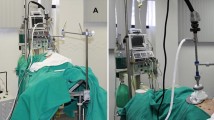Abstract
Background
Peritoneal involvement is a significant issue in the treatment of gastrointestinal malignancies. Current statistics indicate that after surgical intervention, up to 20% of patients will present with locoregional metastasis. The ability to inhibit initial tumor adhesion to the mesothelial lining of the peritoneum may be considered critical in the inhibition of tumor development. This article describes, the use of a novel nebulizer system capable of delivering high-concentration, low-dose therapeutics to the peritoneal cavity.
Methods
For this study, 30 male WAG rats were inoculated with CC531 colorectal tumor cells. The rats were randomized into three groups: control group (n = 10), heparin-treated group (n = 10), and high-molecular-weight hyaluronan-treated group (n = 10). A peritoneal cancer index was used to determine tumor burden at 15 days. Analysis of variance (ANOVA) was used to compare multiple group means.
Results
Nebulization therapy was performed without any complication in the cohort. Heparin inhibited macroscopic intraperitoneal tumor growth completely (p = 0.0001) without affecting tumor cell viability. The introduction of hyaluronan attenuated both tumor size and distribution, was compared with the control group (p = 0.002).
Conclusion
Nebulized heparin and hyaluronic acid using a novel nebulization technique attenuates peritoneal tumor growth after laparoscopic surgery. The technique itself is easy to use and safe.




Similar content being viewed by others
References
Alkhamesi NA, Ziprin P, Pfistermuller K, Peck D, Darzi A (2003) Role of therapeutic intervention in peritoneal carcinomatosis via an ICAM-1–dependent mechanism. Br J Surg 90: 6
Cintron JR, Pearl RK (1996) Colorectal cancer and peritoneal carcinomatosis. Semin Surg Oncol 12: 267–278
Da-Zhi X, You-Qing Z, Xiao-Wei S, Su-Mei C, Qi-Rong G (2004) Meta-analysis of intraperitoneal chemotherapy for gastric cancer. World J Gastroentrol 10: 2727–2730
Eggermont AM, Steller EP, Sugarbaker PH (1987) Laparotomy enhances intraperitoneal tumor growth and abrogates the antitumor effects of interleukin-2 and lymphokine-activated killer cells. Surgery 102: 71–78
Hayen W, Goebeler M, Kumar S, Riessen R, Nehls V (1999) Hyaluronan stimulates tumor cell migration by modulating the fibrin fiber architecture. J Cell Sci 112(Pt 13): 2241–2251
Hubens G, Pauwels M, Hubens A, Vermeulen P, Van Marck E, Eyskens E (1996) The influence of a pneumoperitoneum on the peritoneal implantation of free intraperitoneal colon cancer cells. Surg Endosc 10: 809–812
Jacobi CA, Ordemann J, Bohm B, Zieren HU, Sabat R, Muller JM (1997) Inhibition of peritoneal tumor cell growth and implantation in laparoscopic surgery in a rat model. Am J Surg 174: 359–363
Jakeways MS, Mitchell V, Hashim IA, Chadwick SJ, Shenkin A, Green CJ, Carli F (1994) Metabolic and inflammatory responses after open or laparoscopic cholecystectomy. Br J Surg 81: 127–131
Lessan K, Aguiar DJ, Oegema T, Siebenson L, Skubitz AP (1999) CD44 and beta-1 integrin mediate ovarian carcinoma cell adhesion to peritoneal mesothelial cells. Am J Pathol 154: 1525–1537
Miller SJ, Hoggat AM, Faulk WP (1998) Heparin regulates ICAM-1 expression in human endothelial cells: an example of noncytokine-mediated endothelial activation. Thromb Haemost 80: 481–487
Murthy SM, Goldschmidt RA, Rao LN, Ammirati M, Buchmann T, Scanlon EF (1989) The influence of surgical trauma on experimental metastasis. Cancer 64: 2035–2044
Neuhaus SJ, Ellis T, Jamieson GG, Watson DI (1999) Experimental study of the effect of intraperitoneal heparin on tumour implantation following laparoscopy. Br J Surg 86: 400–404
Ridgway PF, Smith A, Ziprin P, Jones TL, Paraskeva PA, Peck DH, Darzi AW (2002) Pneumoperitoneum augmented tumor invasiveness is abolished by matrix metalloproteinase blockade. Surg Endosc 16: 533–536
Smorenburg SM, van Noorden CJ (2001) The complex effects of heparins on cancer progression and metastasis in experimental studies. Pharmacol Rev 53: 93–105
Sugarbaker PH (1999) Successful management of microscopic residual disease in large bowel cancer. Cancer Chemother Pharmacol 43(Suppl): S15–S25
van den Tol PM, van Rossen EE, van Eijck CH, Bonthuis F, Marquet RL, Jeekel H (1998) Reduction of peritoneal trauma by using nonsurgical gauze leads to less implantation metastasis of spilled tumor cells. Ann Surg 227: 242–248
Yamaguchi K, Hirabayashi Y, Shiromizu A, Shiraishi N, Adachi Y, Kitano S (2001) Enhancement of port-site metastasis by hyaluronic acid under CO2 pneumoperitoneum in a murine model. Surg Endosc 15: 504–507
Yong L, Nduka CC, Dye J, Mansfield A, Darzi A (1997) The effect of laparoscopy on peritoneal fibrinolytic activity. Br J Surg 84: 721–722
Ziprin P, Ridgway PF, Peck DH, Darzi AW (2002) The theories and realities of port-site metastases: a critical appraisal. J Am Coll Surg 195: 395–408
Ziprin P, Ridgway PF, Peck DH, Darzi AW (2003) Laparoscopic-type environment enhances mesothelial cell fibrinolytic activity in vitro via a downregulation of plasminogen activator inhibitor-1 activity. Surgery 134: 758–765
Acknowledgement
This work was supported by Smith and Nephew (USA), Northgate Technologies Incorporated (USA), Trudell Medical International (Canada), and Dr. Rob Goldin, Senior Lecturer and Consultant Pathologist, St. Mary’s Hospital.
Author information
Authors and Affiliations
Corresponding author
Rights and permissions
About this article
Cite this article
Alkhamesi, N.A., Ridgway, P.F., Ramwell, A. et al. Peritoneal nebulizer: a novel technique for delivering intraperitoneal therapeutics in laparoscopic surgery to prevent locoregional recurrence. Surg Endosc 19, 1142–1146 (2005). https://doi.org/10.1007/s00464-004-2214-3
Received:
Accepted:
Published:
Issue Date:
DOI: https://doi.org/10.1007/s00464-004-2214-3




